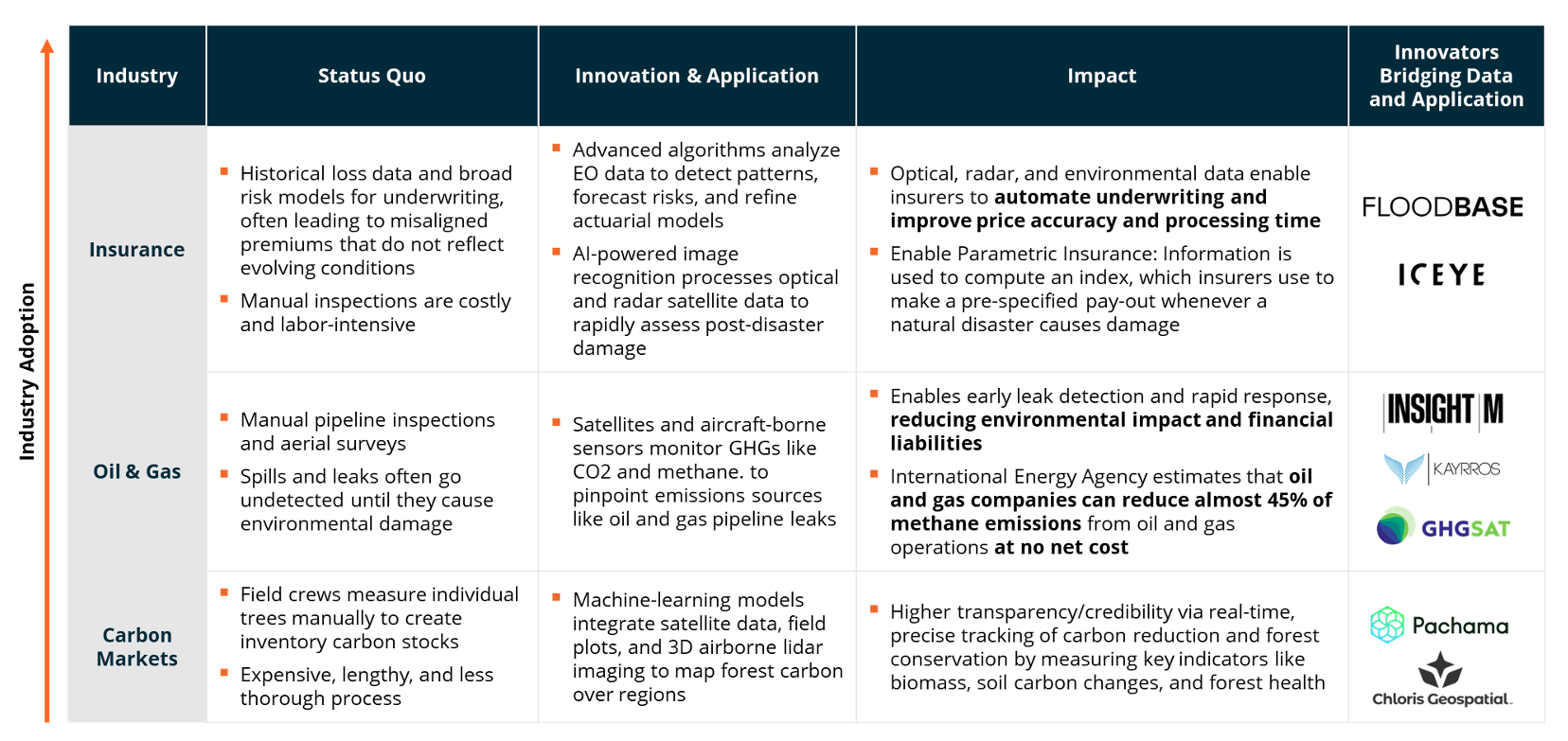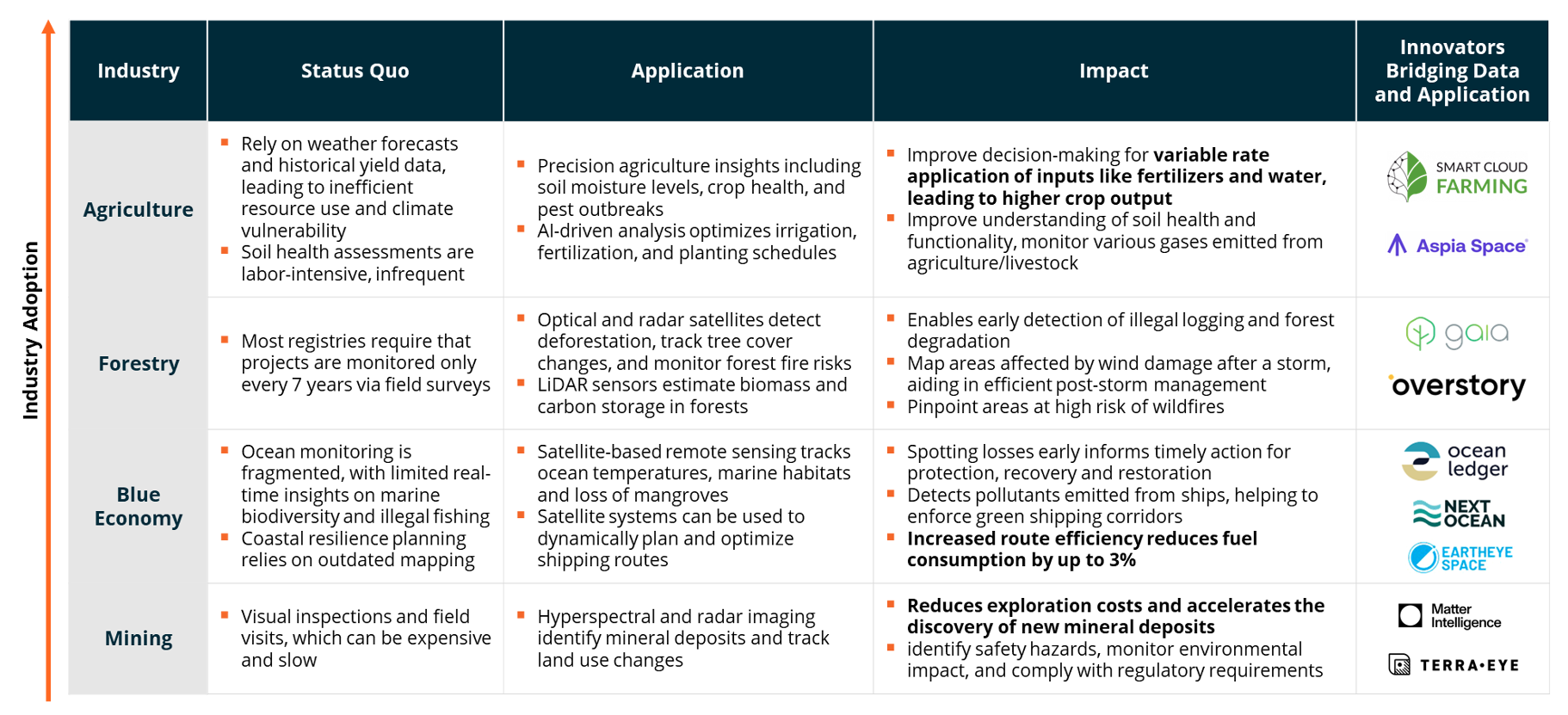Once the exclusive domain of governments and defense agencies, Earth Observation (EO) is now a vital tool for industries tackling climate risks, supply chain management, and regulatory compliance. As climate change accelerates and global regulations tighten, EO technology is transforming how we monitor and respond to environmental challenges.
The EO market has a projected economic value of over $700B by 2030 and the potential to reduce two gigatons of greenhouse gas emissions annually. The number of active EO satellites is expected to nearly triple in the next decade, driven largely by commercial operators. This surge in deployment will lower costs, expand data availability, and fuel new applications as competition intensifies. Nearly 80% of EO’s total economic impact is forecasted to come from climate- and nature-related use cases, with three key outcomes:
- Cost Avoidance: Helps manage natural hazard risks, protect infrastructure, and ensure regulatory compliance to avoid penalties
_ - Mitigation: Enables emissions monitoring and climate variable tracking, supporting mitigation efforts like GHG reduction and carbon capture
_ - Adaptation: Supports ecosystem monitoring to strengthen biodiversity, habitat conservation, and overall ecological health
Tech Innovation is Improving Accessibility and Impact
Cutting-edge technologies are enhancing EO’s capabilities and applications, opening new frontiers in climate monitoring. For example, enhanced sensors now offer superior global coverage and resolution capturing 2-3 times more spectral data than traditional methods. Expansions in Synthetic Aperture Radar (SAR) technology captures images through clouds and darkness, enabling continuous monitoring for flood detection, deforestation tracking, and polar ice measurement. The variety in satellite sizes also expands the scope of use cases.
Smaller, more cost-effective sensors increase the availability of public and commercial EO data and reduce reliance on heavy ground-based equipment, while larger satellites with advanced capabilities are enabling more complex instruments and higher data transmission capacities.
Additionally, data analysis is being transformed, with AI enabling faster and more detailed data analysis. Advanced algorithms process data up to 1,000 times faster than traditional models, allowing AI-powered flood mapping and disaster assessments to be conducted in minutes rather than weeks. Physics-informed climate models, which combine physical principles with machine learning, provide highly localized climate forecasting with significantly improved energy efficiency. Additionally, digital twins, which create virtual replicas of Earth’s climate systems, enable real-time simulation of climate strategies, improving decision-making and risk assessment.
Promising Cleantech Applications
Early adopters include tech-ready industries such as insurance, carbon markets, oil & gas, and mining, which are using EO for strategic decision-making:

Industries like agriculture, maritime, utilities, supply chain, and transportation are expected to capture market share over a longer time period, in line with their propensity to adopt technologies later:

Accelerating Adoption
Stricter climate regulations are pushing industries to adopt EO for compliance and sustainability. For example, the EU Deforestation Regulation (EUDR) incentivizes biodiversity monitoring and deforestation tracking, and the EU Methane Regulation requires satellite-based leak detection for compliance. The Corporate Sustainability Reporting Directive (CSRD) mandates climate risk disclosure for companies listed on EU-regulated markets, while the U.S. SEC Climate Disclosure Rules (2024) require public companies to report on climate-related risks and emissions.
Geographically, adoption trends reflect regional needs. North America, Europe, and Australia are embracing EO to mitigate wildfire risks and comply with environmental regulations. Meanwhile, South and Southeast Asia are leveraging EO for infrastructure resilience and power grid monitoring. There is also an emerging trend of island nations in Asia and Africa prioritizing climate monitoring and defense applications.
Overcoming Challenges
Despite its potential, the high costs and limited access to high-resolution EO datasets can be particularly prohibitive for early-stage innovators. However, open-data initiatives from tech giants like Google and Amazon are helping to increase accessibility and reduce these barriers. Technical expertise also remains a bottleneck for many companies, as EO requires specialized knowledge in satellite engineering, data tasking, and analysis. Furthermore, cross-border data sharing raises concerns about data privacy and national security as sensitive information can be captured, making the technology subject to legal and geopolitical scrutiny.
A Hot Market for Innovation and Investment
Recent acquisitions demonstrate growing confidence in EO start-ups and signal a robust exit market. Notable deals include Neo Space Group acquiring UP42, EarthDaily Analytics acquiring Descartes Labs, Fugro acquiring EOMAP, and Nuview acquiring Astraea. This trend suggests that established players see strategic value in acquiring and integrating innovative EO capabilities rather than developing them in-house.
While climate funding cuts in the U.S. pose challenges, EO innovators can still find stability by addressing dual-use applications, balancing environmental monitoring with defense capabilities. Geopolitical risks and increasing investment in surveillance will continue to sustain the EO market, providing long-term opportunities for firms operating at the intersection of climate and security.
The future of EO lies in the integration of advanced computing, AI, and satellite technology. Emerging innovations such as edge computing and digital twins promise faster, more actionable insights. As the industry evolves, companies that can navigate the trade-offs between coverage, resolution, and persistence while delivering high-value solutions will lead the next wave of EO-driven climate innovation.


